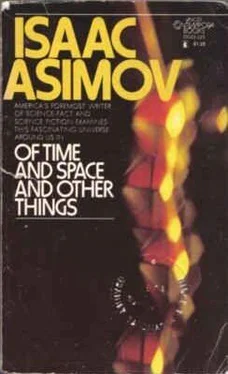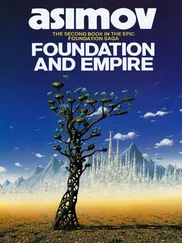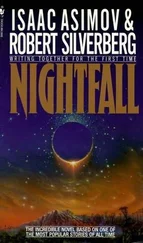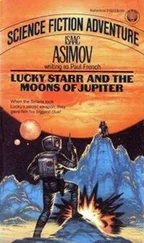Isaac Asimov - Of Time and Space and Other Things
Здесь есть возможность читать онлайн «Isaac Asimov - Of Time and Space and Other Things» весь текст электронной книги совершенно бесплатно (целиком полную версию без сокращений). В некоторых случаях можно слушать аудио, скачать через торрент в формате fb2 и присутствует краткое содержание. Год выпуска: 1972, ISBN: 1972, Издательство: Lancer Books, Жанр: Прочая научная литература, на английском языке. Описание произведения, (предисловие) а так же отзывы посетителей доступны на портале библиотеки ЛибКат.
- Название:Of Time and Space and Other Things
- Автор:
- Издательство:Lancer Books
- Жанр:
- Год:1972
- ISBN:ISBN: 0-447-33023-3
- Рейтинг книги:4 / 5. Голосов: 1
-
Избранное:Добавить в избранное
- Отзывы:
-
Ваша оценка:
- 80
- 1
- 2
- 3
- 4
- 5
Of Time and Space and Other Things: краткое содержание, описание и аннотация
Предлагаем к чтению аннотацию, описание, краткое содержание или предисловие (зависит от того, что написал сам автор книги «Of Time and Space and Other Things»). Если вы не нашли необходимую информацию о книге — напишите в комментариях, мы постараемся отыскать её.
Of Time and Space and Other Things — читать онлайн бесплатно полную книгу (весь текст) целиком
Ниже представлен текст книги, разбитый по страницам. Система сохранения места последней прочитанной страницы, позволяет с удобством читать онлайн бесплатно книгу «Of Time and Space and Other Things», без необходимости каждый раз заново искать на чём Вы остановились. Поставьте закладку, и сможете в любой момент перейти на страницу, на которой закончили чтение.
Интервал:
Закладка:
So we cannot speak of "Venusian atmosphere" or "Venutian atmosphere" as science fiction writers some times do. We must say "Venerian atmosphere." Un fortunately, this has uncomfortable associations and it is not used. We might turn back to the Greek name but the genitive form there is Aphrodisiakos, and if we speak of the "Aphrodisiac atmosphere" I think we will give a false impression.
But something must be done. We are actually exploring the atmosphere of Venus with space probes and some adjective is needed. Fortunately, there is a way out. The Venus cult was very prominent in early days in a small island south of Greece. It was called Kythera (Cythera in Latin spelling) so that Aphrodite was referred to, poetically, as the "Cytherean go'ddess." Our poetic astron omers have therefore taken to speaking of the "Cytherean atmosphere."
The other four planets present no problem. The second brightest planet is truly the king planet. Venus may be brighter but it is confined to the near neighborhood of the Sun and is never seen at midnight. The second brightest, however, can shine through all the hours of night and so it should fittingly be named for the chief god. The Babi lonians accordingly named it "Marduk." The Greeks followed suit and called it "Zeus," and the Romans named it Jupiter. The genitive form of Jupiter is fovis, so that we speak of the "Jovian satellites." A person bom under the astrological influence of Jupiter is "jovial."
Then there -is a reddish planet and red is obviously the color of blood; that is, of war and conflict. The Baby lonians named this planet "Nergal" after their god of war, and the Greeks again followed suit by naming it "Ares" after theirs. Astronomers who study the surface features of the planet are therefore studying "areography." The Latins used their god of war, Mars, for the planet. The genitive form is Martis, so we can speak of the "Martian canals."
The planet nearest the Sun, appears, like Venus, as both an evening star and morning star. Being smaller and less reflective than Venus, as well as closer to the Sun, it is much harder to see. By the time the Greeks got around to naming it, the mythological notion had taken hold. The evening star manifestation was named "Hermes," and the morning star one "Apollo."
The latter name is obvious enough, since the later Greeks associated Apollo with the Sun, and by the time the planet Apollo was in the sky the Sun was due very shortly. Because the planet was closer to the Sun than any other planet (though, of course, the Greeks did not know this was the reason), it moved more quickly against the stars than any object but the Moon. This made it resemble the wing-footed messenger of the gods, Hermes.
But giving the planet two names was a matter of conserv atism. With the Venus matter straightened out, Hermes/Apollo was quickly reduced to a single planet and Apollo was dropped. The Romans named it "Mercurius," which was their equivalent of Hermes, and we call it Mercury.
The quick journey of Mercury across the stars is like the lively behavior of droplets of quicksilver, which came to be called "mercury," too, and we know the type of personality that is described as "mercurial."
There is one planet left. This is the most slowly moving of all the planets known to the ancient Greeks (being the farthest from the Sun) and so they gave it the name of an ancient god, one who would be "pected to move in grave, and solemn steps. They called it "Cronos," the father of Zeus and ruler of the universe before the suc cessful revolt of the Olympians under Zeus's leadership.
The Romans gave it the name of a god they considered the equivalent of Cronos and called it "Saturnus," which to us is Saturn. People born under Saturn are supposed to reflect its gravity and are "satumine."
For two thousand years the Earth, Sun, Moon, Mercury, Venus, Mars, Jupiter, and Saturn remained the only known bodies of the Solar System. Then came 1610 and the Italian astronomer Galileo Galilei, who built himself a telescope and turned it on the heavens. In no time at all he found four subsidiary objects circling the planet Jupiter.
(The German astronomer Johann Kepler promptly named such subsidiary bodies "satellites," from a Latin word for the hangers-on of some powerful man.)
There was a question as to what to name the new bodies.
The mythological names of the planets had hung on into the Christian era, but I imagine there must have been some natural hesitation about using heathen gods for new bodies.
Galileo himself felt it wise to honor Cosimo Medici H, Grand Duke of Tuscany from whom he expected (and later received) a position, and called them Sidera MetUcea (the Medicean stars). Fortunately this didn't stick. Nowa days we call the four satellites the "Galilean satellites" as a group, but individually we use mythological names after all. A German astronomer, Simon Marius, gave them these names after having discovered the satellites one day later than Galileo.
The names are all in honor of Jupiter's (Zeus's) loves, of which there were many. Working outward from Jupiter, the first is lo (two syllables please, eye'oh), a maiden whom Zeus turned into a heifer to hide her from his wife's jealousy. The second is Europa, whom Zeus in the form of a bull abducted from the coast of Phoenicia in Asia and carried to Crete (which is how Europe received its name).
The third is Ganymede, a young Trojan lad (well, the Greeks were liberal about such things) whom Zeus ab ducted by assuming the guise of an eagle. And the fourth is Callisto, a nymph whom Zeus's wife caught and turned into a bear.
As it happens, naming the third satellite for a male rather than for a female turned out to be appropriate, for Ganymede is the largest of the Galilean satellites and, indeed, is the largest of any satellite in the Solar System.
(It is even larger than Mercury, the smallest planet.)
The naming of the Galilean satellites established once and for all the convention that bodies of the Solar System were to be named mythologically, and except in highly unusual instances this custom has been followed since.
In 1655 the Dutch astronomer Christian Huygens dis covered a satellite of Saturn (now known to be the sixth from the planet). He named it Titan. In a way this was appropriate, for Saturn (Cronos) and his brothers and sisters, who ruled the Universe before Zeus took over, were referred to collectively as "Titans." However, since the name refcrs to a group of beings and not to an indi vidual being, its use is unfortunate. The name was ap propriate in a second fashion, too. "Titan" has come to mean "giant" because the Titans and their allies were pictured by the Greeks as- being of superhuman size (whence the word "titanic"), and it turned out that Titan was one of the largest satellites in the Solar System.
The Italian-French astronomer Gian Domenico Cassini was a little more precise than Huygens had been. Between 1671 and 1684 he discovered four more satellites of Saturn, and these he named after individual Titans and Titanesses.
The satellites now known to be 3rd, 4th, and 5th from Saturn he named Tethys, Dione, and Rhea, after three sisters of Saturn. Rhea was Saturn's wife as well. The 8th satellite from Saturn he named Iapetus after one of Satum's brothers. (Iapetus is frequently mispronounced.
In English it is "eye-ap'ih-tus.") Here finally the Greek names were used, chiefly because there were no Latin equivalents, except for Rhea. There the Latin equivalent is Ops. Cassini tried to lump the four satellites he had discovered under the name of "Ludovici" after his patron, Louis XIV-Ludovicus, in Latin-but that second at tempt to honor royalty also failed.
And so within 75 years after the discovery of the tele scope, nine new bodies of the Solar System were discovered, four satellites of Jupiter and five of Saturn. Then some thing more exciting turned up.
Читать дальшеИнтервал:
Закладка:
Похожие книги на «Of Time and Space and Other Things»
Представляем Вашему вниманию похожие книги на «Of Time and Space and Other Things» списком для выбора. Мы отобрали схожую по названию и смыслу литературу в надежде предоставить читателям больше вариантов отыскать новые, интересные, ещё непрочитанные произведения.
Обсуждение, отзывы о книге «Of Time and Space and Other Things» и просто собственные мнения читателей. Оставьте ваши комментарии, напишите, что Вы думаете о произведении, его смысле или главных героях. Укажите что конкретно понравилось, а что нет, и почему Вы так считаете.












